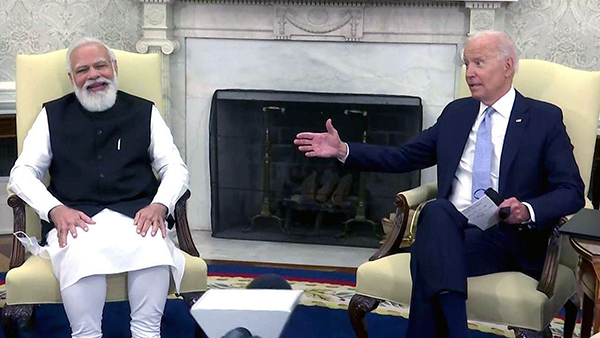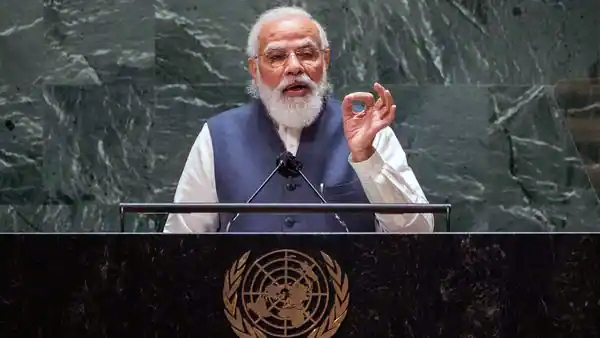
Strengthening Indo-US Comprehensive Global Partnership
Prime Minister Narendra Modi’s visit to the US on 22-25 September 2021 was significant for a number of reasons. His delegation includes External Affairs Minister S Jaishankar, National Security Advisor Ajit Doval and Foreign Secretary Shringla among others.
Ahead of US visit, Modi said his visit to the United States would be an occasion to strengthen the Indo-US Comprehensive Global Strategic Partnership and consolidate ties with Japan and Australia. He said in his address to the United Nations General Assembly he would focus on the pressing global challenges including the Covid-19 pandemic, the need to combat terrorism, climate change, and other important issues. At a media briefing ahead of the prime minister’s visit, foreign secretary Harsh Vardhan Shringla had said the developments in Afghanistan would be extensively discussed in the bilateral talks between Modi and Biden and the Indian side would convey that Washington needed to continue focus on that country.
Prime Minister’s Engagements
23 September
- Modi met US Vice-President Kamala Harris.
- The prime minister met one-on-one with five chief executives of top American companies – Heads of Qualcomm, Adobe, First Solar, General Atomics and Blackstone.
- Modi had bilateral meetings with Australian Prime Minister Scott Morrison and Japanese Prime Minister Yoshihide Suga.
24 September
*Modi participated in the first in-person summit of the Quad in Washington and had an important bilateral meeting with US President Joe Biden.
25 September
*Modi attended the UN General Assembly in New York and addressed the General Debate of the High-Level Segment of the 76th Session of the United Nations General Assembly (UNGA).
*Meeting With Joe Biden
The meeting with Joe Biden was the first in-person meeting between the two leaders after Biden became President in January.
*Biden and Modi discussed the current regional security situation following the recent developments in Afghanistan and a number of other issues. The need to “stem radicalism, extremism, cross-border terrorism and dismantling of global terrorist network”, also featured in the PM Modi-Biden talks.
Other issues on the agenda discussed with President Joe Biden were as follows:
• The Afghan crisis and its implications
• China’s growing assertiveness
• Ways to stem radicalism and cross-border terrorism
• Expansion of the India-US global partnership
• How to bolster bilateral trade and investment ties
• Strengthen defence and security collaboration
• Boost the Strategic Clean Energy Partnership
• Explore new avenues and emerging technologies, including R&D, innovation and industry linkages
Quad Summit
PM Modi also attended the first in-person Quad summit hosted by the US President. Australian Prime Minister Scott Morrison and Japanese Prime Minister Yoshihide Suga also attended the summit. This was Modi’s first in-person meeting with Mr Suga after the latter took over the reins from Shinzo Abe in September last year.
The Quad summit aims to boost cooperation in the Indo-Pacific region amid China’s growing dominance in the area. The Quad countries – Australia, India, Japan and the US – announced a new working group on space, a supply chain initiative and a 5G deployment and diversification effort apart from discussing issues like challenges in the Indo Pacific, climate change and COVID-19 pandemic.
For the US, the Quad meeting marked another step to reviving an American focus on diplomatic efforts, following its dramatic exit from the 20-year Afghanistan war.
Of the three regional groupings that Washington leads in its strategic chess game to manage China’s ascent, the Quad is deliberately the most open. The other two are the “Five Eyes” intelligence-sharing alliance, comprising Australia, Canada, New Zealand, the United Kingdom and the United States, and the newest arrival on the block – AUKUS.
Meeting with Kamala Harris
During his first meeting with US Vice President Kamala Harris, Modi latter brought up Pakistan’s role in terrorism and asked Islamabad to take action so it does not impact America and India’s security.
Modi and Harris had earlier spoken on the telephone in June this year. Harris had offered to prioritise India, in making US vaccines available in the wake of the Covid situation at that time in India.
Address to UN General Assembly
PM Modi will conclude the US visit with an address at the United Nations General Assembly, focusing on global challenges including the pandemic, the need to combat terrorism, climate change and other important issues.
India – US Issues
India and the US are close partners and share an economic and military relationship. Bilateral trade was $88.75 billion (Rs 6.5 lakh crore) in 2019-20, and the stated goal is of taking it to $500 billion (Rs 36.9 lakh crore) over the current decade. A new trade deal between the two countries is off the table but there are other areas of mutual convergence.
- Defence. Since being designated a ‘major defence partner’ by the US in 2016, India has been able to access cutting-edge US military technology. Both countries conduct more military exercises with each other than with any other country. Over the past 15 years, India has bought arms worth $22 billion (Rs 1.6 lakh crore) from the US and is negotiating a fresh batch of defence deals worth approximately $10 billion (Rs 73,825 crore). The new deals include those for 30 MQ-9B Predator drones, worth approximately $3 billion (Rs 22,147 crore), additional C-130J transport aircraft and NASAMS-II air defence missile systems. India wants this relationship to move into the realm of joint development and to include more cutting-edge prowess in the field of stealth technologies, jet fighter engines and nuclear propulsion reactor technology.
- Terrorism and Afghanistan. Since the swift takeover of Afghanistan by the Taliban and the shocking collapse of the earlier Democratic Republic of Afghanistan and its US-trained and equipped military, both India and the US have common concerns about Afghanistan becoming a hub of terrorism, with terrorists operating out of safe havens there to target the world outside, as it was during the previous Taliban rule between 1996 and 2001. A shared concern is intelligence cooperation after the US pullout to warn of possible terror threats. The immediate issue at hand is the push by the Taliban to gain global legitimacy, including claiming its seat at the United Nations. The US aims to exert leverage on the Islamist group using what Secretary of State Antony Blinken said last month was a “range of tools”.
- Climate Change. The two countries this year launched a new high-level team-up—the ‘US-India Climate and Clean Energy Agenda 2030 Partnership’. The partnership envisages bilateral cooperation to meet the goals of the 2015 Paris Agreement. Its goal is to limit global warming to well below 2 degrees Celsius, preferably 1.5 degrees Celsius, compared to pre-industrial levels. To achieve this long-term goal, countries aim to reach global peaking of greenhouse gas emissions as soon as possible to achieve a climate-neutral world by mid-century.
- The US has set an economy-wide target of reducing its net greenhouse gas emissions by 50-52 per cent below 2005 levels in 2030. As part of its climate mitigation efforts, India has set a target of installing 450 GW of renewable energy by 2030. The two countries are to collaborate on this 2030 agenda for clean technologies and climate action. The first announcement in this direction was made in New Delhi when Special Presidential Envoy for Climate John Kerry travelled to launch the initiative in April 2021.
- Free and open Indo-Pacific. China’s rise as a military power has sparked global anxiety and uncertainty, particularly with regard to the South China Sea that Beijing has militarised and claims as its territorial waters. Over $5 trillion (Rs 7.3 lakh crore) worth of trade, which is over 60 per cent of the global maritime trade, passes through the South China Sea. An immediate response to China’s belligerence has been the revival of the Quadrilateral Security Dialogue, or Quad, in March this year. The Quad countries—US, India, Australia and Japan—are to hold their first in-person meeting at the White House this week after a virtual summit last year. India and the US have reiterate their commitment to a ‘free and open Indo-Pacific’—a region comprising the Indian Ocean, the western and central Pacific Ocean and including the South China Sea.
- Vaccine Exports. In April, India halted vaccine exports after it was hit by a crippling second wave of the Covid-19 pandemic but resumed them from October. Indian manufacturers source raw materials, such as sterile filters and disposable bags for cell culture, used in vaccine production from the US. At a global Covid-19 summit on September 22, PM Modi emphasised that India would be stepping up vaccine production. He said India wants the vaccine raw material supply chains to be kept open so that it could step up vaccine production and resume exports to other countries. Global vaccine supply, particularly to the poorer countries, remains a huge bottleneck. The World Health Organization (WHO) has flagged vaccine inequity wherein a majority of the over 5 billion vaccines have been administered by the rich nations and the poorer countries were left to fend for themselves. President Biden has committed to donating 1.1 billion vaccine doses to the poorer countries, especially those in Africa. This is another area of collaboration between the two countries.


















